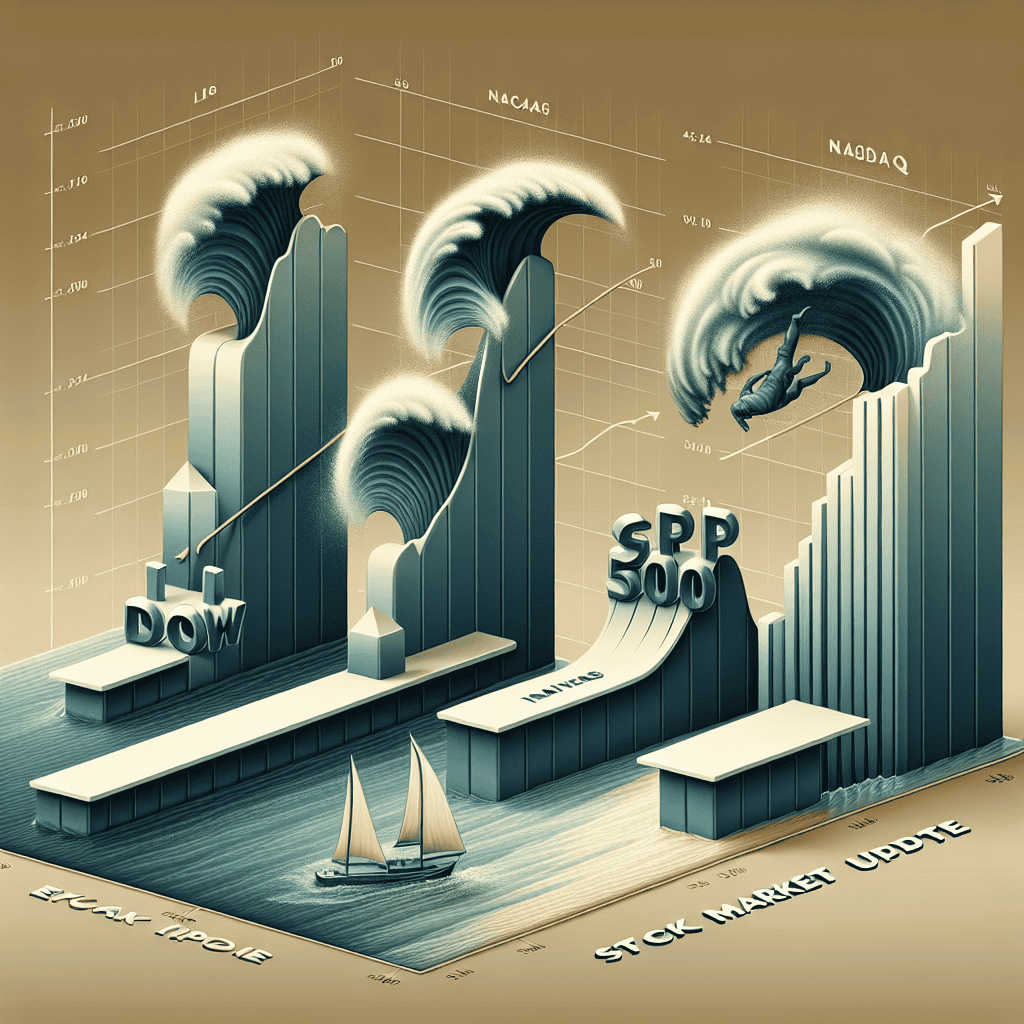“Market Waves: Dow Dips, S&P 500 and Nasdaq Ride Earnings Tide”
Introduction
The stock market experienced a mixed session today as the Dow Jones Industrial Average dipped, while the S&P 500 and Nasdaq Composite showed fluctuations amid a surge in corporate earnings reports. Investors are closely monitoring the latest financial results from major companies, which are providing insights into the health of various sectors and the broader economy. The earnings season has brought both positive surprises and disappointments, contributing to the volatility observed in the markets. As traders digest these reports, they are also weighing the potential impact of macroeconomic factors, including interest rate policies and geopolitical developments, on future market performance.
Dow Dips: Analyzing the Impact on Investor Sentiment
The recent dip in the Dow Jones Industrial Average has sparked a wave of analysis and speculation among investors and market analysts alike. As the Dow experiences a downturn, the S&P 500 and Nasdaq have shown fluctuations, reflecting the broader market’s response to a surge in corporate earnings reports. This dynamic environment has led to a complex interplay of factors influencing investor sentiment, which is crucial to understanding the current market landscape.
To begin with, the Dow’s decline can be attributed to several key factors, including mixed earnings results from major corporations. While some companies have reported robust earnings, exceeding market expectations, others have fallen short, leading to a cautious approach among investors. This mixed bag of earnings has created a sense of uncertainty, prompting investors to reassess their portfolios and strategies. Consequently, the Dow’s dip is not merely a reflection of poor performance but rather an indication of the market’s reaction to varied corporate outcomes.
Moreover, the fluctuations in the S&P 500 and Nasdaq further underscore the market’s volatility. The S&P 500, which represents a broader spectrum of the market, has shown resilience in the face of the Dow’s decline, suggesting that investors are still finding opportunities in certain sectors. Meanwhile, the Nasdaq, heavily weighted towards technology stocks, has experienced its own set of fluctuations. This is largely due to the tech sector’s sensitivity to interest rate changes and global economic conditions, which have been in flux recently.
In addition to earnings reports, external factors such as geopolitical tensions and economic indicators have also played a role in shaping investor sentiment. For instance, ongoing trade negotiations and international conflicts can create an atmosphere of uncertainty, leading investors to adopt a more conservative stance. Similarly, economic indicators such as inflation rates and employment figures can influence market perceptions, as they provide insights into the overall health of the economy.
Transitioning to the psychological aspect, investor sentiment is a critical component in understanding market movements. When the Dow dips, it can trigger a psychological response among investors, leading to a phenomenon known as herd behavior. This occurs when investors, driven by fear or uncertainty, collectively move in the same direction, often exacerbating market trends. Understanding this behavior is essential for investors seeking to navigate the complexities of the stock market.
Furthermore, the role of institutional investors cannot be overlooked. These large entities, such as mutual funds and pension funds, have significant influence over market trends due to their substantial holdings. Their reactions to earnings reports and economic indicators can set the tone for the broader market, impacting individual investor sentiment. As such, monitoring the actions of institutional investors can provide valuable insights into potential market shifts.
In conclusion, the recent dip in the Dow, coupled with fluctuations in the S&P 500 and Nasdaq, highlights the intricate web of factors influencing investor sentiment. From corporate earnings and economic indicators to psychological responses and institutional actions, each element plays a vital role in shaping the market’s direction. As investors navigate this complex landscape, understanding these dynamics is crucial for making informed decisions and capitalizing on potential opportunities. By staying informed and maintaining a strategic approach, investors can better position themselves to weather the uncertainties of the stock market.
S&P 500 Fluctuations: What It Means for Your Portfolio
The recent fluctuations in the S&P 500 have captured the attention of investors and analysts alike, as the index experiences a period of volatility amid a surge in corporate earnings reports. This dynamic environment presents both challenges and opportunities for those managing investment portfolios. Understanding the implications of these fluctuations is crucial for making informed decisions that align with one’s financial goals.
To begin with, the S&P 500, a benchmark index that represents the performance of 500 of the largest publicly traded companies in the United States, serves as a barometer for the overall health of the stock market. When the index experiences fluctuations, it often reflects broader economic trends and investor sentiment. Recently, the S&P 500 has been oscillating due to a combination of factors, including mixed earnings results, geopolitical tensions, and changing monetary policies. These elements contribute to the uncertainty that investors must navigate.
One of the primary drivers of the current fluctuations is the ongoing earnings season, during which companies report their financial performance for the previous quarter. While some companies have exceeded expectations, others have fallen short, leading to mixed reactions in the market. For instance, technology giants have reported robust earnings, buoyed by strong demand for digital services and products. Conversely, sectors such as retail and manufacturing have faced challenges due to supply chain disruptions and rising costs. This divergence in performance has resulted in a lack of clear direction for the S&P 500, causing it to fluctuate as investors reassess their positions.
Moreover, the Federal Reserve’s monetary policy plays a significant role in influencing market behavior. As the central bank signals potential interest rate hikes to combat inflation, investors are recalibrating their strategies. Higher interest rates can lead to increased borrowing costs for companies, potentially impacting their profitability. Consequently, sectors that are sensitive to interest rate changes, such as real estate and utilities, may experience heightened volatility. Investors must consider these factors when evaluating their portfolios, as shifts in monetary policy can have far-reaching effects on asset prices.
In addition to domestic factors, global events also contribute to the S&P 500’s fluctuations. Geopolitical tensions, such as trade disputes and conflicts, can create uncertainty and affect investor confidence. For example, ongoing trade negotiations between major economies can influence market sentiment, as investors weigh the potential impact on global supply chains and economic growth. In such an environment, diversification becomes a key strategy for mitigating risk. By spreading investments across different asset classes and geographic regions, investors can reduce their exposure to specific market shocks.
Ultimately, the recent fluctuations in the S&P 500 underscore the importance of maintaining a well-balanced and diversified portfolio. While short-term volatility can be unsettling, it is essential to focus on long-term investment objectives. Investors should regularly review their portfolios to ensure alignment with their risk tolerance and financial goals. Additionally, staying informed about market trends and economic developments can provide valuable insights for making strategic adjustments.
In conclusion, the current fluctuations in the S&P 500 reflect a complex interplay of factors, including corporate earnings, monetary policy, and global events. For investors, understanding these dynamics is crucial for navigating the market’s ups and downs. By adopting a disciplined approach and maintaining a diversified portfolio, investors can better position themselves to weather volatility and achieve their financial objectives over the long term.
Nasdaq’s Volatility: Opportunities and Risks for Traders
In recent weeks, the Nasdaq has exhibited significant volatility, presenting both opportunities and risks for traders navigating the complex landscape of the stock market. As the Dow Jones Industrial Average experiences a dip, the S&P 500 and Nasdaq have fluctuated amid a surge in corporate earnings reports. This dynamic environment has prompted investors to reassess their strategies, balancing the potential for substantial gains against the inherent risks of a volatile market.
The Nasdaq, known for its heavy concentration of technology and growth-oriented stocks, has been particularly sensitive to the latest earnings announcements. Companies within this index have reported mixed results, with some exceeding expectations while others have fallen short. This disparity in performance has contributed to the index’s erratic movements, as traders react swiftly to new information. Consequently, the Nasdaq’s volatility has created a fertile ground for short-term trading opportunities, allowing astute investors to capitalize on rapid price swings.
However, the potential for profit is accompanied by significant risk. The unpredictable nature of the Nasdaq’s fluctuations can lead to substantial losses for those who fail to accurately anticipate market movements. Traders must remain vigilant, employing robust risk management strategies to protect their investments. This includes setting stop-loss orders, diversifying portfolios, and staying informed about the latest market developments. By doing so, traders can mitigate the impact of adverse price movements and enhance their ability to navigate the volatile landscape.
Moreover, the current market environment underscores the importance of understanding the broader economic context. Factors such as interest rate changes, inflationary pressures, and geopolitical tensions can all influence market sentiment and contribute to the Nasdaq’s volatility. For instance, recent concerns about potential interest rate hikes by the Federal Reserve have added an additional layer of complexity to the market, as investors weigh the implications of tighter monetary policy on growth stocks. In this context, traders must remain attuned to macroeconomic indicators and adjust their strategies accordingly.
In addition to external economic factors, the performance of individual companies within the Nasdaq also plays a crucial role in shaping the index’s trajectory. As earnings season progresses, traders are closely monitoring the results of key players in the technology sector, such as Apple, Amazon, and Microsoft. These companies’ financial health and future outlooks can significantly impact investor sentiment, driving the Nasdaq’s movements. Positive earnings surprises can lead to sharp upward movements, while disappointing results may trigger sell-offs.
Furthermore, the rise of algorithmic trading and high-frequency trading has amplified the Nasdaq’s volatility. These automated systems can execute trades at lightning speed, reacting to market signals and news events in real-time. While this can enhance liquidity and efficiency, it also increases the potential for rapid and unpredictable price swings. Traders must be aware of these dynamics and consider their implications when formulating their strategies.
In conclusion, the Nasdaq’s current volatility presents both opportunities and risks for traders. By staying informed, employing sound risk management practices, and understanding the broader economic context, investors can navigate this challenging environment with greater confidence. As the market continues to evolve, traders must remain adaptable, ready to seize opportunities while safeguarding their investments against potential pitfalls.
Earnings Surge: Key Takeaways from Recent Financial Reports

In recent weeks, the stock market has experienced a series of fluctuations, with the Dow Jones Industrial Average dipping while the S&P 500 and Nasdaq Composite have shown varied movements. This volatility can be largely attributed to the ongoing earnings season, which has seen a surge in financial reports from major corporations. As investors digest these reports, the market’s response has been mixed, reflecting both optimism and caution.
The earnings season has been marked by a notable increase in corporate profits, with many companies surpassing analysts’ expectations. This surge in earnings has been driven by several factors, including robust consumer demand, cost-cutting measures implemented during the pandemic, and strategic investments in technology and innovation. As a result, sectors such as technology, healthcare, and consumer goods have reported strong performances, contributing to the overall positive sentiment in the market.
However, despite these encouraging earnings reports, the market has not responded uniformly. The Dow’s recent dip can be attributed to a combination of factors, including concerns over inflationary pressures and supply chain disruptions. These issues have particularly affected industrial and manufacturing companies, which are heavily represented in the Dow. As these companies grapple with rising input costs and logistical challenges, their stock prices have faced downward pressure, contributing to the index’s decline.
In contrast, the S&P 500 and Nasdaq have shown more resilience, buoyed by the strong performance of technology and growth-oriented companies. The technology sector, in particular, has continued to thrive, with companies reporting impressive revenue growth and expanding profit margins. This has been fueled by ongoing digital transformation efforts and increased demand for tech products and services. Consequently, the Nasdaq, which is heavily weighted towards technology stocks, has experienced fluctuations but remains relatively stable.
Moreover, the S&P 500, which encompasses a broader range of industries, has benefited from the diverse earnings reports across sectors. While some industries face headwinds, others have capitalized on emerging opportunities, balancing the index’s overall performance. For instance, the healthcare sector has seen a boost from advancements in pharmaceuticals and medical devices, while consumer goods companies have leveraged strong brand loyalty and innovative product offerings to drive sales.
As investors navigate this complex landscape, they are also keeping a close eye on macroeconomic indicators and policy developments. The Federal Reserve’s stance on interest rates and monetary policy continues to be a focal point, as any changes could significantly impact market dynamics. Additionally, geopolitical tensions and global economic trends remain influential factors that could sway investor sentiment.
In conclusion, the current earnings season has provided valuable insights into the financial health of major corporations, revealing both strengths and vulnerabilities. While the Dow has faced challenges, the S&P 500 and Nasdaq have demonstrated resilience, underscoring the importance of sectoral diversity in the market. As the earnings season progresses, investors will continue to assess the implications of these financial reports, balancing optimism with caution as they make informed decisions. Ultimately, the stock market’s trajectory will depend on a confluence of corporate performance, economic conditions, and external factors, making it imperative for investors to stay vigilant and adaptable in this ever-evolving environment.
Market Trends: How the Dow, S&P 500, and Nasdaq Interact
In the ever-evolving landscape of financial markets, the interplay between major indices such as the Dow Jones Industrial Average, the S&P 500, and the Nasdaq Composite often serves as a barometer for economic sentiment and investor behavior. Recently, the Dow experienced a slight dip, while the S&P 500 and Nasdaq exhibited fluctuations, reflecting the complex dynamics at play amid a surge in corporate earnings reports. Understanding how these indices interact provides valuable insights into broader market trends and investor strategies.
The Dow Jones Industrial Average, often referred to simply as the Dow, is a price-weighted index comprising 30 prominent companies across various sectors. Its recent decline can be attributed to several factors, including sector-specific challenges and broader economic concerns. As a price-weighted index, the Dow is particularly sensitive to the performance of its higher-priced constituents. Consequently, a downturn in a few key stocks can disproportionately impact the index’s overall performance. This characteristic underscores the importance of examining individual company earnings and sectoral trends when analyzing the Dow’s movements.
In contrast, the S&P 500, a market-capitalization-weighted index, offers a more comprehensive view of the U.S. stock market by encompassing 500 of the largest publicly traded companies. Its recent fluctuations highlight the diverse responses of different sectors to the current earnings season. While some industries, such as technology and healthcare, have reported robust earnings, others, like energy and consumer staples, face headwinds due to fluctuating commodity prices and shifting consumer preferences. These sectoral divergences contribute to the S&P 500’s volatility, as investors reassess their portfolios in light of new financial data.
Meanwhile, the Nasdaq Composite, heavily weighted towards technology and growth-oriented companies, has also experienced notable fluctuations. The tech sector’s performance is often a focal point for investors, given its significant influence on the Nasdaq’s trajectory. Recent earnings reports from major tech firms have been mixed, with some companies exceeding expectations while others grapple with supply chain disruptions and regulatory challenges. These mixed results have led to a cautious approach among investors, contributing to the Nasdaq’s recent volatility.
The interaction between these indices is further complicated by external factors such as monetary policy, geopolitical tensions, and macroeconomic indicators. For instance, the Federal Reserve’s stance on interest rates can have a profound impact on market sentiment, influencing investor decisions across all three indices. Additionally, global events, such as trade negotiations or political developments, can introduce uncertainty, prompting investors to seek safe-haven assets or adjust their risk exposure.
As earnings season progresses, market participants will continue to scrutinize corporate performance and guidance for the coming quarters. The interplay between the Dow, S&P 500, and Nasdaq will remain a focal point for analysts and investors alike, as they navigate the complexities of a dynamic market environment. By understanding the unique characteristics and sectoral compositions of these indices, investors can better anticipate potential market movements and make informed decisions.
In conclusion, the recent dip in the Dow, coupled with fluctuations in the S&P 500 and Nasdaq, underscores the intricate relationship between these major indices. As they respond to a myriad of factors, including corporate earnings, sectoral trends, and external influences, their interactions offer a window into the broader market landscape. For investors, staying attuned to these dynamics is essential for navigating the challenges and opportunities that lie ahead in the financial markets.
Investment Strategies: Navigating a Fluctuating Stock Market
In the ever-evolving landscape of the stock market, investors are constantly seeking strategies to navigate the fluctuations that characterize this dynamic environment. Recently, the Dow Jones Industrial Average experienced a dip, while the S&P 500 and Nasdaq Composite exhibited fluctuations amid a surge in corporate earnings reports. This scenario underscores the importance of adopting informed investment strategies to effectively manage portfolios during periods of market volatility.
To begin with, understanding the factors contributing to the current market movements is crucial. The recent dip in the Dow can be attributed to a combination of macroeconomic factors, including concerns over inflation, interest rate adjustments by the Federal Reserve, and geopolitical tensions. These elements have collectively created an environment of uncertainty, prompting investors to reassess their positions. Meanwhile, the S&P 500 and Nasdaq have shown fluctuations as companies across various sectors release their earnings reports, providing insights into their financial health and future prospects.
In light of these developments, investors are advised to adopt a diversified investment approach. Diversification, a fundamental principle in portfolio management, involves spreading investments across different asset classes, sectors, and geographic regions. This strategy helps mitigate risk by reducing the impact of poor performance in any single investment. For instance, while technology stocks may experience volatility, investments in consumer staples or healthcare sectors might provide stability, thereby balancing the overall portfolio performance.
Moreover, it is essential for investors to maintain a long-term perspective. Market fluctuations, while often unsettling, are a natural part of the investment cycle. Historical data suggests that markets tend to recover over time, rewarding patient investors who remain committed to their investment goals. By focusing on long-term objectives and avoiding impulsive decisions based on short-term market movements, investors can better position themselves to achieve sustainable growth.
In addition to diversification and a long-term outlook, staying informed about market trends and economic indicators is vital. Regularly reviewing financial news, analyst reports, and economic forecasts can provide valuable insights into potential market shifts. This knowledge enables investors to make informed decisions, such as adjusting asset allocations or identifying emerging opportunities. Furthermore, consulting with financial advisors can offer personalized guidance tailored to individual risk tolerance and financial objectives.
Another strategy to consider is dollar-cost averaging, which involves investing a fixed amount of money at regular intervals, regardless of market conditions. This approach reduces the impact of market volatility by spreading out investments over time, potentially lowering the average cost per share. By consistently investing, investors can take advantage of market dips and accumulate more shares when prices are lower, ultimately enhancing their long-term returns.
Finally, it is important to remain adaptable and open to adjusting strategies as market conditions evolve. The stock market is influenced by a myriad of factors, including technological advancements, regulatory changes, and global events. Being flexible and willing to reassess investment strategies in response to new information can help investors capitalize on emerging trends and mitigate potential risks.
In conclusion, navigating a fluctuating stock market requires a combination of informed strategies, patience, and adaptability. By diversifying portfolios, maintaining a long-term perspective, staying informed, and employing techniques such as dollar-cost averaging, investors can effectively manage the challenges posed by market volatility. As the Dow dips and the S&P 500 and Nasdaq fluctuate amid an earnings surge, these strategies provide a robust framework for achieving financial success in an unpredictable market environment.
Economic Indicators: Understanding Their Influence on Market Movements
In the ever-evolving landscape of financial markets, economic indicators play a pivotal role in shaping investor sentiment and guiding market movements. Recently, the Dow Jones Industrial Average experienced a dip, while the S&P 500 and Nasdaq Composite exhibited fluctuations, largely influenced by a surge in corporate earnings reports. Understanding the interplay between these economic indicators and market behavior is crucial for investors seeking to navigate the complexities of the stock market.
Economic indicators, such as GDP growth rates, unemployment figures, and consumer confidence indices, provide valuable insights into the health of an economy. These indicators serve as barometers, reflecting the underlying economic conditions that can influence corporate performance and, consequently, stock prices. For instance, robust GDP growth often signals a thriving economy, potentially leading to increased consumer spending and higher corporate profits. Conversely, rising unemployment rates may indicate economic distress, prompting concerns about reduced consumer spending and lower earnings for companies.
In the current market scenario, the recent dip in the Dow Jones Industrial Average can be attributed to a combination of factors, including mixed economic data and investor reactions to corporate earnings reports. As companies release their quarterly earnings, investors scrutinize these reports to assess the financial health and future prospects of businesses. Positive earnings surprises can boost investor confidence, leading to stock price increases, while disappointing results may trigger sell-offs.
The S&P 500 and Nasdaq Composite, on the other hand, have shown fluctuations as investors digest a wave of earnings reports from major technology firms and other sectors. The technology sector, in particular, has been a focal point for investors, given its significant influence on the Nasdaq. As tech giants report their earnings, any deviation from market expectations can lead to volatility in the index. For example, better-than-expected earnings from a leading tech company can drive the Nasdaq higher, while a miss can result in a decline.
Moreover, the interplay between economic indicators and market movements is further complicated by external factors such as geopolitical tensions, monetary policy decisions, and global economic trends. Central banks, for instance, play a crucial role in shaping market dynamics through their monetary policy actions. Interest rate decisions, in particular, can have a profound impact on stock markets. A rate hike may lead to higher borrowing costs for companies, potentially dampening investment and growth prospects, while a rate cut could stimulate economic activity by making borrowing cheaper.
In addition to these factors, investor sentiment and market psychology also play a significant role in driving market movements. During periods of uncertainty, such as the current earnings season, market participants may exhibit heightened sensitivity to news and data releases. This can lead to increased volatility as investors react swiftly to new information, adjusting their portfolios in response to perceived risks and opportunities.
In conclusion, the recent movements in the Dow, S&P 500, and Nasdaq underscore the intricate relationship between economic indicators and stock market behavior. As investors navigate this complex landscape, understanding the influence of economic data, corporate earnings, and external factors is essential for making informed investment decisions. By staying attuned to these dynamics, investors can better position themselves to capitalize on opportunities and mitigate risks in an ever-changing market environment.
Q&A
1. **Question:** What was the performance of the Dow Jones Industrial Average in the recent stock market update?
– **Answer:** The Dow Jones Industrial Average dipped in the recent stock market update.
2. **Question:** How did the S&P 500 perform in the latest stock market activity?
– **Answer:** The S&P 500 fluctuated amid the recent stock market activity.
3. **Question:** What was the movement of the Nasdaq in the stock market update?
– **Answer:** The Nasdaq also experienced fluctuations in the stock market update.
4. **Question:** What was a significant factor influencing the stock market’s performance?
– **Answer:** A surge in earnings reports was a significant factor influencing the stock market’s performance.
5. **Question:** Did any specific sector or company report earnings that impacted the market?
– **Answer:** The question does not specify, but typically, major tech companies or financial institutions reporting earnings can impact the market.
6. **Question:** How did investors react to the earnings reports in terms of market behavior?
– **Answer:** Investors showed mixed reactions, leading to fluctuations in the S&P 500 and Nasdaq.
7. **Question:** What is a potential implication of the current stock market trends for future trading sessions?
– **Answer:** The current trends suggest potential volatility in future trading sessions as investors digest earnings reports.
Conclusion
In conclusion, the recent stock market activity reflects a mixed performance, with the Dow Jones Industrial Average experiencing a decline while the S&P 500 and Nasdaq Composite show volatility amid a surge in corporate earnings reports. This fluctuation indicates investor uncertainty and varied responses to earnings results, economic indicators, and potential market-moving events. The divergence in index performances suggests sector-specific influences and differing investor sentiment, highlighting the importance of closely monitoring earnings announcements and broader economic trends for future market direction.





